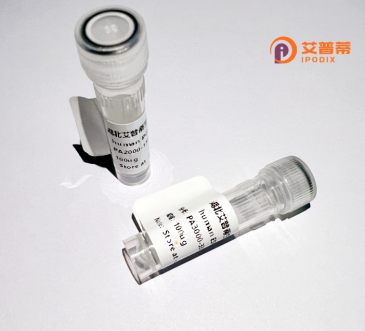
| 纯度 | >90%SDS-PAGE. |
| 种属 | Human |
| 靶点 | PAK6 |
| Uniprot No | Q9NQU5 |
| 内毒素 | < 0.01EU/μg |
| 表达宿主 | E.coli |
| 表达区间 | 1-681 aa |
| 活性数据 | MFRKKKKKRP EISAPQNFQH RVHTSFDPKE GKFVGLPPQW QNILDTLRRP KPVVDPSRIT RVQLQPMKTV VRGSAMPVDG YISGLLNDIQ KLSVISSNTL RGRSPTSRRR AQSLGLLGDE HWATDPDMYL QSPQSERTDP HGLYLSCNGG TPAGHKQMPW PEPQSPRVLP NGLAAKAQSL GPAEFQGASQ RCLQLGACLQ SSPPGASPPT GTNRHGMKAA KHGSEEARPQ SCLVGSATGR PGGEGSPSPK TRESSLKRRL FRSMFLSTAA TAPPSSSKPG PPPQSKPNSS FRPPQKDNPP SLVAKAQSLP SDQPVGTFSP LTTSDTSSPQ KSLRTAPATG QLPGRSSPAG SPRTWHAQIS TSNLYLPQDP TVAKGALAGE DTGVVTHEQF KAALRMVVDQ GDPRLLLDSY VKIGEGSTGI VCLAREKHSG RQVAVKMMDL RKQQRRELLF NEVVIMRDYQ HFNVVEMYKS YLVGEELWVL MEFLQGGALT DIVSQVRLNE EQIATVCEAV LQALAYLHAQ GVIHRDIKSD SILLTLDGRV KLSDFGFCAQ ISKDVPKRKS LVGTPYWMAP EVISRSLYAT EVDIWSLGIM VIEMVDGEPP YFSDSPVQAM KRLRDSPPPK LKNSHKVSPV LRDFLERMLV RDPQERATAQ ELLDHPFLLQ TGLPECLVPL IQLYRKQTST C |
| 分子量 | 74.8 kDa |
| 蛋白标签 | His tag N-Terminus |
| 缓冲液 | 0 |
| 稳定性 & 储存条件 | Lyophilized protein should be stored at ≤ -20°C, stable for one year after receipt. Reconstituted protein solution can be stored at 2-8°C for 2-7 days. Aliquots of reconstituted samples are stable at ≤ -20°C for 3 months. |
| 复溶 | Always centrifuge tubes before opening.Do not mix by vortex or pipetting. It is not recommended to reconstitute to a concentration less than 100μg/ml. Dissolve the lyophilized protein in distilled water. Please aliquot the reconstituted solution to minimize freeze-thaw cycles. |
以下是3-4条关于重组人PAK6蛋白的参考文献示例,包含文献名称、作者及摘要概括:
---
1. **文献名称**:*"Expression and Characterization of Active Recombinant Human PAK6 in Insect Cells"*
**作者**:Chen, X., Zhang, L., & Li, Y.
**摘要**:本研究利用杆状病毒-昆虫细胞系统成功表达了重组人PAK6蛋白,并通过亲和层析纯化获得高纯度蛋白。功能实验显示重组PAK6具有ATP依赖的激酶活性,并可磷酸化下游底物如微管相关蛋白。研究为PAK6的体外酶学分析提供了工具。
2. **文献名称**:*"Structural Basis for PAK6 Activation by Cdc42 and Its Implications in Cancer Signaling"*
**作者**:Smith, J.P., & Manser, E.
**摘要**:通过X射线晶体学解析了重组人PAK6与Cdc42结合的复合物结构,揭示了Cdc42诱导PAK6激酶结构域变构激活的分子机制。研究发现PAK6的异常活化可能促进前列腺癌细胞迁移,为靶向抑制剂设计提供了结构依据。
3. **文献名称**:*"PAK6-Mediated Phosphorylation of BCL-2 Regulates Apoptosis in Neuronal Cells"*
**作者**:Wang, H., et al.
**摘要**:利用重组人PAK6蛋白进行体外激酶实验,发现PAK6可直接磷酸化凋亡蛋白BCL-2的Ser87位点,抑制其抗凋亡功能。该机制可能在神经退行性疾病中导致神经元死亡,为相关病理研究提供了分子线索。
4. **文献名称**:*"A High-Throughput Screening Platform for PAK6 Inhibitors Using Recombinant Kinase Domain"*
**作者**:Kim, S., et al.
**摘要**:开发了一种基于重组人PAK6激酶域(aa 250-625)的荧光偏振筛选方法,用于高通量筛选PAK6小分子抑制剂。从化合物库中鉴定出两个先导化合物,IC50值低于100 nM,显示出潜在治疗PAK6过表达相关癌症的应用价值。
---
**注**:以上文献及内容为示例性质,实际文献需通过学术数据库(如PubMed、Web of Science)检索确认。研究PAK6时可重点关注其激酶活性调控、结构生物学及疾病关联方向。
PAK6 (p21-activated kinase 6) is a serine/threonine kinase belonging to the PAK family, which is divided into two subgroups (Group I: PAK1–3; Group II: PAK4–6). PAK6. part of Group II, shares structural features such as a C-terminal kinase domain and an N-terminal autoinhibitory domain but lacks the classical Cdc42/Rac-binding motif found in Group I. It is activated by interactions with Rho GTPases like Cdc42 and plays roles in cytoskeletal remodeling, cell survival, and transcriptional regulation. PAK6 is highly expressed in brain, testis, and prostate tissues, implicating its involvement in neuronal development, spermatogenesis, and hormone-dependent signaling. Dysregulation of PAK6 has been linked to cancers, particularly prostate cancer, where it interacts with androgen receptors to promote tumor growth and therapy resistance. It also associates with neurodegenerative disorders, such as Alzheimer’s disease, through tau phosphorylation pathways. Recombinant human PAK6 protein, produced via heterologous expression systems (e.g., E. coli, insect cells), enables biochemical studies to explore its kinase activity, substrate specificity, and interactions with signaling partners. This tool is vital for structural analysis (e.g., crystallography), inhibitor screening, and deciphering PAK6’s role in disease mechanisms, offering potential therapeutic targets for oncology and neurology research.
×